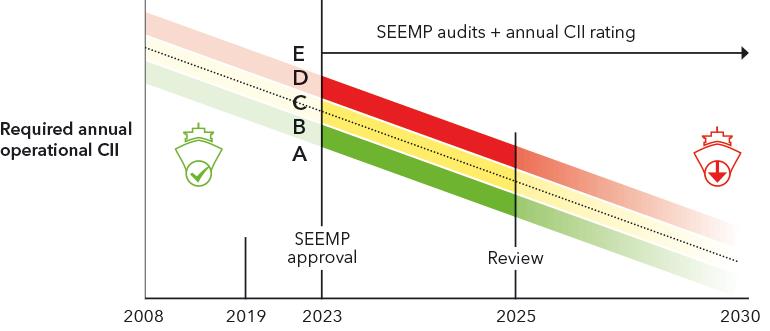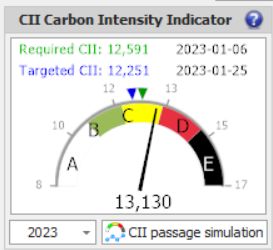CII attained
The CII (Carbon Intensity Indicator) measures how efficiently a vessel above 5,000 GT transports goods or passengers and is given in grams of CO2 emitted per cargo-carrying capacity and nautical mile.
The first reporting of the CII based on 2023 data is due no later than 31 March 2024. Vessels will receive a rating of A (major superior), B (minor superior), C (moderate), D (minor inferior) or E (inferior performance level). The rating thresholds will become increasingly stringent towards 2030. A vessel rated D for three consecutive years or rated as E, will need to develop a plan of corrective actions.
The first reporting of the CII based on 2023 data is due no later than 31 March 2024. Vessels will receive a rating of A (major superior), B (minor superior), C (moderate), D (minor inferior) or E (inferior performance level). The rating thresholds will become increasingly stringent towards 2030. A vessel rated D for three consecutive years or rated as E, will need to develop a plan of corrective actions.
source: DNV
Calculation of annual CII
The CII unit is “grams of CO2 emitted per cargo-carrying capacity and nautical mile”, whereby cargo capacity is either deadweight or gross tons depending on ship type. In addition, to cater for special design and operational circumstances, the correction factors and voyage adjustments can be applied to the basic CII calculations for the purposes of determining the rating.
The CII unit is “grams of CO2 emitted per cargo-carrying capacity and nautical mile”, whereby cargo capacity is either deadweight or gross tons depending on ship type. In addition, to cater for special design and operational circumstances, the correction factors and voyage adjustments can be applied to the basic CII calculations for the purposes of determining the rating.

source: DNV

Advices for the Masters
CII attained depends on total fuel consumption and distance gone.
VOYAGER provides live CII attained indicator (gauge) which shows all necessary data:
- present CII attained,
- required CII,
- targeted CII,
- present rating (A - E)
The hand of the clock shows present location of the vessel in ratings boundaries
CII attained depends on total fuel consumption and distance gone.
VOYAGER provides live CII attained indicator (gauge) which shows all necessary data:
- present CII attained,
- required CII,
- targeted CII,
- present rating (A - E)
The hand of the clock shows present location of the vessel in ratings boundaries

source: DNV
Button "CII passage simulation" opens simulation dialog window.
That functionality is designed to advance CII attained after planned sea passage or port stay, anchor stay.
That functionality is designed to advance CII attained after planned sea passage or port stay, anchor stay.
See also:
CII attained simulation- general information about Carbon Intensity Indicator (CII attained) simulation
CII reference data - general information about CII reference data
CII reference data operations - new, edit, delete for CII reference data
CII attained simulation- general information about Carbon Intensity Indicator (CII attained) simulation
CII reference data - general information about CII reference data
CII reference data operations - new, edit, delete for CII reference data
| Information | |
| The attained CII may be corrected for consumption related to fuel consumption for cargo heating or cooling, navigation in ice, STS (ship-to-ship) bunker operations. Shipyards, drydocking and technical off-hires are not deducted. | |